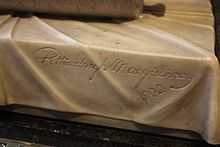James Pittendrigh Macgillivray



Dr. James Pittendrigh MacGillivray (1856 - 29 April 1938) was a prominent Scottish sculptor. He was also a keen amateur poet, musician and artist. He was born in Inverurie, Aberdeenshire, the son of a sculptor, and studied under William Brodie and John Mossman. His works include public statues of Robert Burns in Irvine, Lord Byron in Aberdeen, the 3rd Marquess of Bute in Cardiff, John Knox in Edinburgh's St Giles Cathedral, and William Ewart Gladstone in Coates Crescent Gardens, Edinburgh.
His work was influenced greatly by Pictish designs, and these are on display in Perth. He is sometimes linked with the Scottish Renaissance movement. Hugh MacDiarmid was amongst his admirers.
Alloway village hall contains his sculpture of Robert Burns.
MacGillivray also published two volumes of verse which draw on Doric dialect and earlier forms of Lowland Scots - Pro Patria in 1915 and Bog Myrtle and Peat Reek in 1922. He became a member of the Royal Scottish Academy in 1901 and was appointed the King's Sculptor in Ordinary for Scotland in 1921.
A member of Glasgow Art Club for over fifty years, closely associating himself with the Glasgow Boys, on the evening of 28 October 1932 the Club hosted a dinner in his honour (with fellow honoree fellow club member James B. Anderson ARSA.) [1] He was also a co-founder of "The Scottish Arts Review".
He was a Scottish nationalist, and was associated with Hugh MacDiarmid's Scottish Renaissance movement.
He moved to Edinburgh in 1894 causing the focus of his work to move from Glasgow to Edinburgh.
He is buried in the tiny Gogar Kirkyard, close to the Royal Bank of Scotland headquarters at Gogarburn, with his wife Frieda who died in 1910. The grave is of his own design, depicting them side by side.
Notable works
- Statue of David Livingstone in Cathedral Square, Glasgow (1875) as assistant to main sculptor:John Mossman
- Statue of Thomas Campbell (poet) in George Square Glasgow (1875-7) still as assistant to John Mossman the main sculptor.
- Portrait bust of Joseph Crawhall, one of the "Glasgow Boys" (1881)
- Figures over the inner loggia (west) on Glasgow City Chambers (1886)
- Monument to Peter Stewart in Glasgow Necropolis (1887)
- Monument to Alexander McCall in Glasgow Necropolis (1888)
- Monument to Margaret and Annie Brown in Cathcart Cemetery, Glasgow (1888)
- Bust of Rev James Shanks in Maryhill Parish Church (1889) (demolished 1998)
- Typanum relief group on Anderson's Medical College, 56 Dumbarton Road, Partick (1889-1890) (commissioned by James Sellars its architect. This depicts the 16th century physician Peter Lowe with his students. plus a pair of winged figures.
- Monument to Annie Greenhill in Glasgow Necropolis (1889)
- Portrait bust of Thomas Carlyle (1889)
- Monument to Sir James Robertson in Glasgow Necropolis (1889)
- Figures of the Engineer and Shipwright on Fairfield Shipbuilding and Engineering Company Office (1890)
- Monument to James Sellars architect and his friend, Lambhill Cemetery, Glasgow (1890) his bronze relief portrait was sadly stolen.
- Medallion of Peter Lowe in Glasgow Cathedral (1893)
- Monument to Alexander Allan and his family, Glasgow Necropolis (1894-9)
- Statue of Robert Burns in Irvine (1895)
- Medallion of Edward Caird in Glasgow University (1897)
- Reclining marble effigy of James Francis Montgomery in St Mary's Episcopal Cathedral, Edinburgh (1902)
- Statue of Lord Byron in Aberdeen (1902)
- William Gladstone Memorial in Edinburgh (1902)
- Statue of John Knox in Edinburgh (1902)
- Statue of the 3rd Marquess of Bute in Cardiff (1902)
- Portrait medallion of Henry Drummond (evangelist) on the Henry Drummond Memorial Fountain at Kelvingrove Park Gates (1902...now lost)
- Sculpted figures on Dumfries Public Library (1904)
- Medallion of Henry Drummond (evangelist) in the Free Church College, Edinburgh (1905)
- Grave for his wife Frieda in Gogar Churchyard (1910)
External links
References
- ↑ Glasgow Herald article 29 October 1932 ‘’Glasgow Art Club Two Members Honoured’’ Retrieved 2011-08-17
|